
West Adams is a historic neighborhood in the South Los Angeles region of Los Angeles, California. The area is known for its large number of historic buildings, structures and notable houses and mansions throughout Los Angeles. It is a youthful, densely populated area with a high percentage of African American and Latino residents. The neighborhood has several public and private schools.
Lester Sherwood Moore (1871–1924) was an American architect.
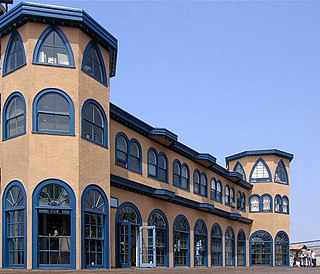
The Santa Monica Looff Hippodrome is located on the Newcomb Pier adjacent to the Santa Monica Pier in Santa Monica, California. It was designed and built in 1916 by Charles I. D. Looff and his son Arthur to hold a Looff Carousel. Looff's carousel was housed at the Hippodrome until it was sold in 1939. It was replaced by Philadelphia Toboggan Company Carousel #62, which was moved from the Ocean Park Pier. The building remains a rare example of structures that used to be on the amusement pier, and scenes were filmed therein for the 1973 award-winning film, The Sting. Since 1977, the carousel has been owned by the city, and was restored from 1977 through 1981. It was declared a National Historic Landmark in 1987.

Horatio West Court, built in Santa Monica, California in 1919, is an early example of attached houses with shared pedestrian and vehicle access. The six little buildings are grouped on a 60-foot lot. It was designed by Irving Gill.

Charmont Apartments is an historic apartment building in Santa Monica, California which was built in 1928. Designed by architect Max Maltzman with elements of both the Mission Revival-Spanish Colonial Revival style and the Art Deco style, the Charmont was a luxurious high-rise when it was built. The blending of Spanish Colonial Revival and Art Deco elements was popular style in the 1920s and is sometimes known as "Med-Deco." The main entrance is located in a walled courtyard that features a two-tiered fountain with an intricate Moorish-patterned backsplash in polychrome tile. The building was damaged in the 1994 Northridge earthquake and subsequently rehabilitated and listed on the National Register of Historic Places.
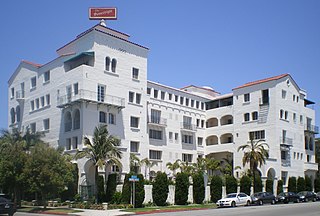
The Sovereign is a large five-story, 130 unit apartment building in Santa Monica, California, United States. Built in 1928, it was designed by architect Kurt Meyer-Radon and the Anglo American Building Company in the Mission Revival-Spanish Colonial Revival styles.
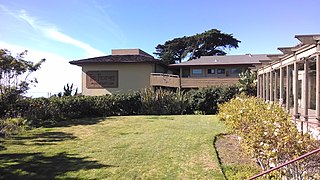
The Pierpont Inn is a Craftsman bungalow-style Inn in Ventura, California on a bluff overlooking the Santa Barbara Channel. Built in 1910 for motoring tourists, the complex is City of San Buenaventura Historic Landmark Number 80.

The North University Park Historic District is a historic district in the North University Park neighborhood of Los Angeles, California. The district is bounded by West Adams Boulevard on the north, Magnolia Avenue on the west, Hoover Street on the east, and 28th Street on the south. The district contains numerous well-preserved Victorian houses dating back as far as 1880. In 2004, the district was added to the National Register of Historic Places.

Bungalow Heaven is a neighborhood in Pasadena, California named for the more than 800 small craftsman homes built there from 1900 to 1930, most of which still stand. Much of the area became a landmark district in 1989 and annual historic home tours have been conducted in Bungalow Heaven every year since then.

The Minnie Hill Palmer House, also known as The Homestead Acre, is the only remaining homestead cottage in the San Fernando Valley. The cottage is a redwood Stick-Eastlake style American Craftsman-Bungalow located on a 1.3-acre (0.53 ha) site in Chatsworth Park South in the Chatsworth section of Los Angeles, California.

This is a list of the National Register of Historic Places listings in Pasadena, California.

Elmer Grey, FAIA was an American architect and artist based in Pasadena, California. Grey designed many noted landmarks in Southern California, including the Beverly Hills Hotel, the Huntington Art Gallery, the Pasadena Playhouse and Wattles Mansion. He is credited with being one of the pioneers in the development of the new American architecture in the early 20th century, with a focus on harmony with nature and eliminating features not belonging to the local climate and conditions. Grey was also a noted artist whose paintings are in the permanent collection of the Chicago Art Institute.
Meyer & Holler was an architecture firm based in Los Angeles, California, noted for its opulent commercial buildings and movie theatres, including Grauman’s Chinese and Egyptian theatres, built during the 1920s. Meyer & Holler was also known as The Milwaukee Building Company.
In the United States, the National Register of Historic Places classifies its listings by various types of architecture. Listed properties often are given one or more of 40 standard architectural style classifications that appear in the National Register Information System (NRIS) database. Other properties are given a custom architectural description with "vernacular" or other qualifiers, and others have no style classification. Many National Register-listed properties do not fit into the several categories listed here, or they fit into more specialized subcategories.
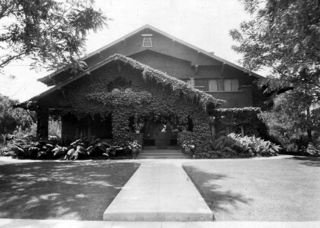
The Paul Shoup House, also known as the Shoup House, is a historic residence in Los Altos, Santa Clara County, California, United States. It was built as an American Craftsman- and Shingle-style home in 1910 for railroad executive Paul Shoup. In 2011 it was designated a historic site by the National Register of Historic Places; the first such designation in Los Altos.

First Baptist Church of Ventura is a historic church at 101 S. Laurel Street in Ventura, California. It was built in 1926 and renovated extensively into the Mayan Revival style in 1932. Declared a landmark by the City of Ventura In 1975, the building was added to the National Register of Historic Places in 2009. Since 1952, it has been home to the Ventura Center for Spiritual Living.

The Ebell Club of Santa Paula is a 1917 mansion, built as a women's club with the aim of the advancement of culture, and now serving as the home of the Santa Paula Theater Center. The Santa Paula chapter, formed in 1913, was the ninth California women's club; the first was established in Oakland by Dr. Adrian Ebell in 1876, and the movement was involved in a range of progressive campaigning on social issues.
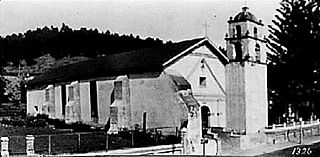
The City of Ventura Historic Landmarks and Districts consist of buildings, sites, and neighborhoods designated by the City of Ventura, California, as historic landmarks and districts.





















